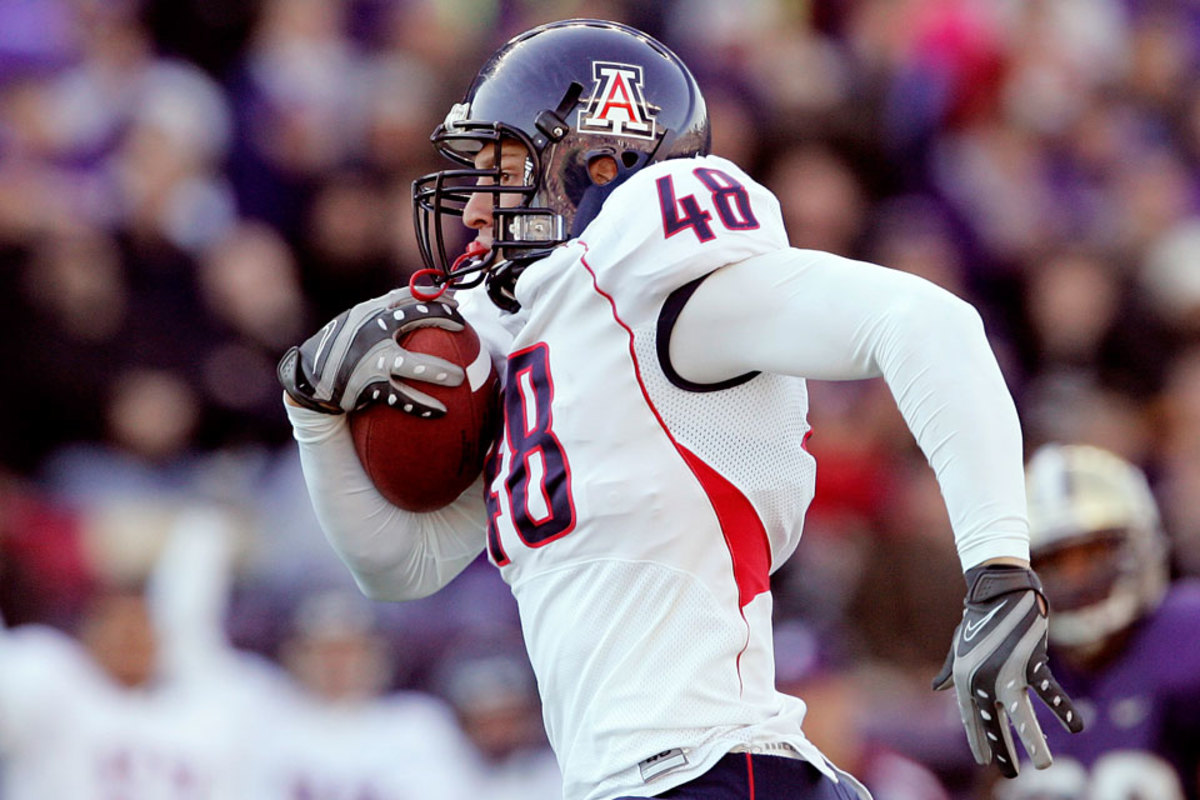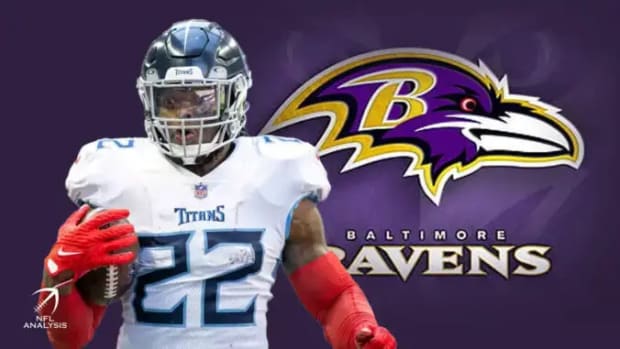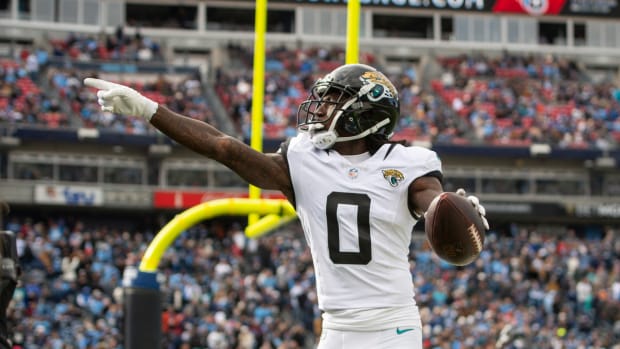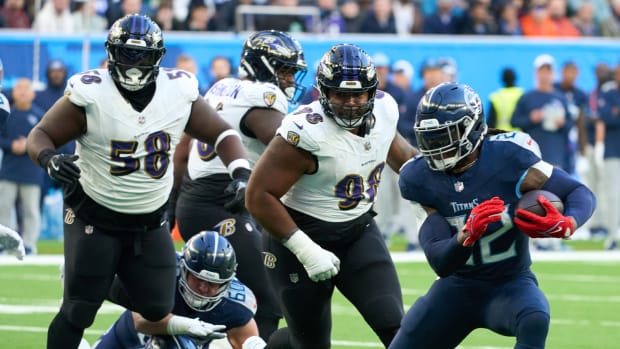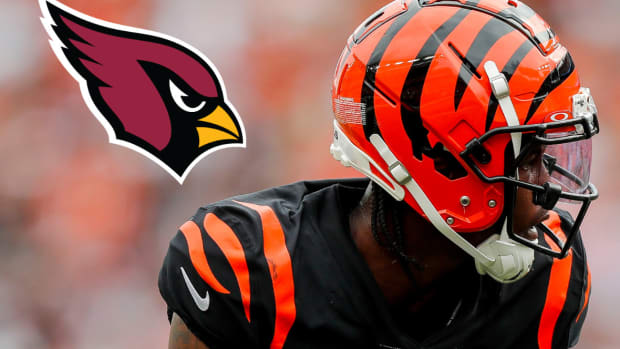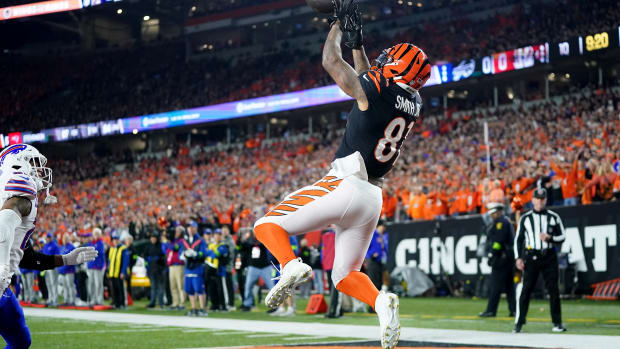Gronk’s Biggest Gamble
BY ROB GRONKOWSKI
with Jason Rosenhaus
Every year in high school and college, I took my game to the next level. I made a huge leap my freshman year at Arizona, and an even bigger leap my sophomore year, after I had learned the ropes. Going into my junior year in 2009, I was no longer adjusting to the daily challenges of playing college football. When spring practices came around I felt strong, elusive and dominant. I felt indestructible, and I knew I would be the best tight end in the country. My coaches knew it, too, and they were going to feature me.
I was also excited because my brother Dan had just been selected by the Lions in the 2009 draft. My brother Chris, who was my teammate at Arizona, and I were determined to play with Dan in the NFL next year. My game plan was for us both to come out after this 2009 season—Chris as a senior and me as a junior.
Since I was so highly rated going into the year, my dad wanted me to take out a disability insurance policy for $4 million, which was the maximum we could get. I knew better than to second-guess him when it came to business, so I took his advice and appreciated his buying that policy for me.
After spring practice ended in April, I didn’t want to lose any momentum, so I lifted weights in the gym with Chris like a madman. One day the guys in the gym were all doing deadlifts. I had never done deadlifts before as part of my training, but one of the team strength trainers was supervising it, so I figured why not? I should have paced myself and stayed at lighter weights, but I got all macho, maxed it out and went too heavy. On the last set I felt something pop in my back. It didn’t feel right, but I finished lifting through the pain. I didn’t think anything of it.
Copyright © 2015 by Rob Gronkowski. From the forthcoming book IT’S GOOD TO BE GRONK, by Rob “Gronk” Gronkowski and Jason Rosenhaus, to be published by Jeter Publishing/Gallery Books, a Division of Simon & Schuster, Inc. Printed by permission. Click on book cover image to purchase the book.
All through April and May I kept lifting and running. By July I had mad back pain, and at the end of the month it was so bad that the nerves in my legs weren’t working. My legs felt like they weighed 500 pounds each, and I couldn’t jump or run. I finally told my dad and trainers.
An MRI on my back showed a badly ruptured disk that was damaging the nerves in my spinal cord. I got a first, second and third medical opinion. Dr. Robert Watkins, a specialist in California, laid out a two-step approach for me. First I would try physical therapy to rehab the back. If that didn’t work I would have surgery to remove the part of the disk that was sticking out into the nerves in my spinal cord. If the nerves wouldn't heal from the injury, I would have permanent damage to my legs. I couldn't believe it had gotten this bad.
Now I had to hope that by working crazy hard in rehab, I could fix my back in time to play that season. There was another option, though: I could retire and collect the $4 million insurance, tax-free, at the age of 19 . . . but that would mean I couldn’t play football anymore. I did the calculations, and at four percent annual interest I could make $160,000 a year without touching the $4 million principal. But I didn’t want the easy money. I wanted to earn it, playing football. Maybe a lot of people would take the money and run, but I looked at it as quitting. I was happy playing football and didn’t want to give that up. So I decided to try physical therapy. It was a long shot, but I had to try.
* * *
Randy Cohen, my trainer at Arizona, worked with me as if it was his own body on the line. The pain in my back and the numbness in my legs started going away. I felt stronger and faster each day. The second week of practice during the 2009 season, I ran some routes to see if I was ready to start practicing. I felt good while I was running, but later that night the shooting pains down my legs and the numbness all came back. I knew lying in my bed in the middle of the night, in pain that made me sweat right through my bedsheets, that my season was done.
I was supposed to be the man, the best tight end in college football. Instead I was sitting in a recliner, facing the possibility that I might never have full use of my legs.
I flew out to California with my dad and had the surgery. Dr. Watkins explained to me that the disk had ruptured and the parts of it that broke off were pressing against the nerves in the spinal cord, causing nerve damage. The procedure was for Dr. Watkins to use an instrument like a small pair of tweezers to poke a small hole through the ruptured disk, grab the broken-off part of the disk, and fish it out. The scary part was that even if all that happened and the surgery was a success, the nerve damage would have to reverse itself. If the nerves didn’t heal all the way back, I would have permanent nerve damage and lose full use of my legs.
During the first three weeks after surgery, I couldn’t do anything but walk to class and sit in a recliner. I was fragile, and every wrong move sent sharp pain up my spine and down my legs. I was supposed to be the man, the best tight end in college football. Instead I was facing the possibility that I might never have full use of my legs again no matter how hard I tried.
Sitting there every night, not able to party, not having fun, not getting wild, could have easily gotten the best of me, but I blocked out the fear and didn’t focus on the negatives. I think it’s because I’m such a big kid at heart and always joking around that I’m able to keep the pressure from getting to me. There’s no reason you can’t work hard, do what you are supposed to and still have fun in the process.
Gronkowski was All-Pac 10 as a sophomore, averaging 18.8 yards per catch and leading the conference in touchdown receptions. (Peter Read Miller/Sports Illustrated)
At some schools, once you’re out for the year they kind of forget about you and treat you like a second-class citizen. That wasn’t the case at Arizona. When I got into the rehab with Randy, he worked with me as if I was the star player getting ready for the big game this week, even though everyone knew I was done for the season, and maybe forever. This time, though, I wasn’t working hard for fun or to be the best. This time I was working to save my career and regain the full use of my legs. I looked at it like I had been preparing for this challenge my whole life—I just didn’t know it until I was faced with the biggest fight of my life. I learned from my dad that everyone works hard, but the winners are the ones who are trained to pay attention to the details and perfect all the little things. By mid-December I was doing light running and was progressing. I felt good and like myself again.
Same Old Gronk—or Maybe Better
Now I had a hard decision to make, and three options to choose from: retire, stay in school for 2010 and play my senior year or enter the 2010 draft as a junior.
The key was that my tax-free $4 million insurance policy gave me until the third game of the 2010 college season to retire and collect the money. If I did that, I could stay in school, get my degree and be set for life. If I played past my third game and then reinjured my back, I would get nothing. On the other hand, if I stayed healthy I could finish college and then go on to play in the NFL in 2011.
The other option was to immediately start training for the NFL combine in February. If that training went well I could enter the 2010 draft, and if it didn’t I could go back to Arizona. I had to make the decision about the combine by January 15, the deadline for college juniors to declare for the draft.
Dr. Watkins said my disk had healed perfectly, and there were no more fragments in the spinal canal. I was happy but not surprised. I lost my junior year of football. I lost my strength, my feeling of invincibility, but not my confidence and sense of humor. I admit that it hurt not to be part of the team, not to be on the field and having fun with the guys. I was happy for Chris and my teammates when they won, but I wasn’t able to party, to celebrate and get wild and go crazy having fun like I was used to doing. I couldn’t enjoy the experience of college life. I was lucky, though: I had Dr. Watkins and a great trainer to help me. Everything I had gone through had made me tougher and more determined to play football again. And getting the green light from Dr. Watkins made me rev my engines and put the pedal to the metal.
* * *
Decisions, decisions ... (Rick Friedman for Sports Illustrated/The MMQB)
That month of training between December 15 and January 15 would be absolutely critical to my chances of playing in the NFL. It was time to work harder than I had every worked in my life. I started training with Pete Bommarito in Miami in mid-December, so I had about a month to make my decision. My dad was on the phone with Pete every day getting the progress report. It would be up to Pete to determine if I could be ready to work out for teams at a high level in March, or if I needed to go back to school and give it until September. Pete worked me from 6 a.m. until 7 p.m. every day. I was constantly doing something—pool work, light jogging, light lifting, working on the treadmill, getting a massage, getting electrical treatments, and getting all kinds of specialized therapy that he could throw at me.
Whatever I was asked to do I did exactly how they showed me to do it and each time with maximum effort. I was never late and never missed a session. I ate the foods Pete had prepared for me and went to bed at the time he told me to shut it down. Thank God I had Chris with me. He kept it fun and helped me get through the frustration of being behind while everyone was healthy and running full speed. With Chris there, we were always joking around and keeping it light. When I’m not working, my mind is on fun things; when I’m working, my mind is focused on that, and so either way I’m distracted from the pressure. The only time the scary thoughts got in my head was at night, and by then I was too exhausted to do anything but sleep.
I lost my junior year of football. I lost my strength, my feeling of invincibility, but not my confidence.
Dr. Watkins explained to me that the success of getting my legs back to full speed would depend on how hard I worked and followed instructions. After that, I became a straight A student at rehabbing my back and legs. I trusted in Dr. Watkins, Randy Cohen and Pete Bommarito. I trusted in my ability to take in everything they told me and apply it. I trusted in my willpower to heal my body. I bought in 100 percent to what my team of experts told me.
Pete told us on January 13 that it was his professional opinion I would be able to make a good enough recovery to reach the average level of athleticism for an NFL tight end. He said there was a decent chance I could make it back all the way to have above average athleticism for an NFL tight end, but that was up in the air.
That was all I needed to hear—that I had a shot to make it all the way back. I knew all along that I didn’t want the insurance money, that I wanted to be an NFL player and live that life to the fullest. I didn’t hesitate and made the decision to come out, to turn down the $4 million tax-free insurance money and enter the 2010 draft.
* * *
The payoff: a second-round selection by the Patriots. (Jason DeCrow/AP)
When, a little more than three months later, on the Friday night of the draft, the Patriots called to say the were trading up to get me in the second round, I was as emotional as I’ve ever been in my life. I got off the phone, and my dad brought us all in to a huddle. I gave him and my mom huge hugs and held back tears. Then Commissioner Goodell said, “With the 42nd pick in the 2010 NFL draft, the New England Patriots select Rob Gronkowski, tight end, Arizona.”
We went wild and all hugged each other. I took the podium, put on my Patriot cap and then grabbed a Patriot helmet. After I thanked the commissioner, Deion Sanders interviewed me on stage, and I told him, “This is the greatest moment of my life. This is unbelievable.” I was holding back tears as I talked. I was so happy. My family and I were overwhelmed with emotion. I had been through so much, missing this past year and almost having the game taken away from me. Now I was a New England Patriot. We formed a huddle and chest bumped each other, and I put the helmet on and screamed at the top of my lungs at the TV camera. We hooted and hollered until the Patriots called back and told me to get off the stage. Right then and there we let the NFL and the Patriots know you better watch out! The Gronks are coming to town, and we are going to bring it!
To order IT’S GOOD TO BE GRONK, click here.
Follow The MMQB on Facebook, Twitter and Instagram.
[widget widget_name="SI Newsletter Widget”]
































